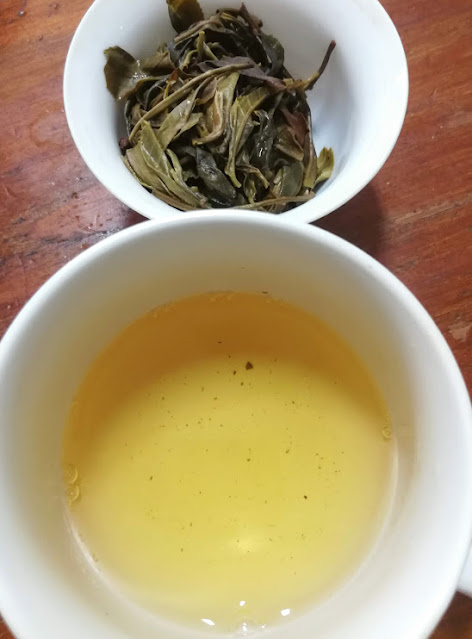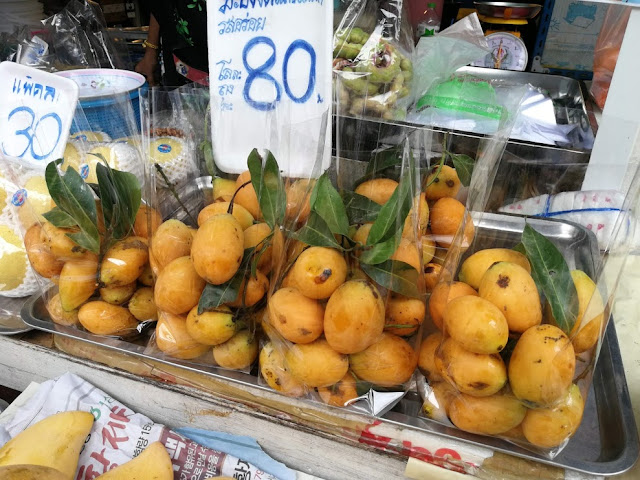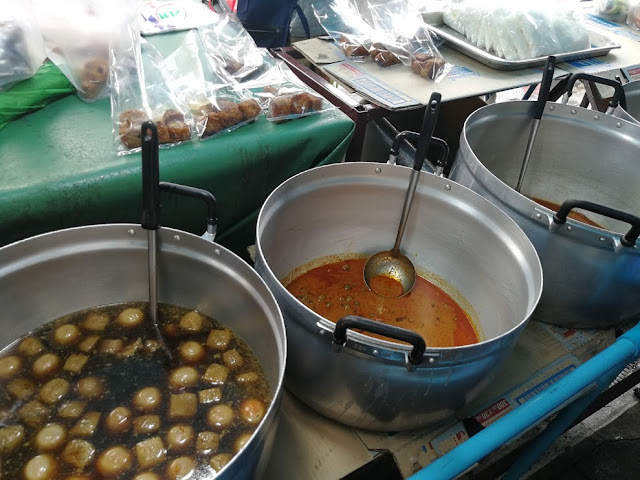 |
photo credit Suzana, as usual |
Another meetup! At least the people we meet with are completely different, from different parts of the world, varied cultures, and with completely different takes on tea. This time my friends--Suzana, Ralph, and Huyen--and I met with Josh Linvers, a Canadian tea vendor and sommelier (on Facebook, Instagram, and his own vending and blog reference site).
An hour into this session we were still on random small-talk, covering a bit here and there on how we got into tea, on Japanese and Vietnamese versions, tea history, and broad preference trends, all over the map. It didn't seem like this was going to lead to something unified to write here about. Eventually the tea sommelier theme came up; that works better. As an aside, his site name is "sommerier," which someone might wonder about relating to tea instead of wine, but dictionary.com seems to clear this up:
ORIGIN OF SOMMELIER
1920–25; <French, Middle French, dissimilated form of *sommerier, derivative of sommier one charged with arranging transportation, equivalent to somme burden (<Late Latin sagma horse load <Greek ságma covering, pack saddle)
I wrote the basics about Joshua's thoughts on tea pairing with food last year, with a longer and more detailed summary on his own page about that. It's not that complicated, or at least the basics aren't. Tea can't necessarily stand up to strong flavors in foods the way wine can, so it needs to play a more complementary role. Most typically you can't pair similar combinations, because it overpowers the tea expression of the same scope, so you need to settle on offsetting balance, aspects that enhance each other, which is where it gets more complicated. A quote from a wine-making friend in that post describes that context well, from Dan Senkow, a really great guy, very insightful and funny in his own way:
In simple terms one may either use an element in the wine to compare or contrast. So, this may be done with flavors, textures, weights, or a mixture of the above. Example a heavy lobster bisque with a light crisp wine or a rich opulent creamy one.
So the creamy wine--or tea, in this example--won't match with a creamy soup, because real cream in a lobster bisque is much heavier and stronger than it could ever be in a milk oolong (Jin Xuan), so that oolong could end up tasting like water. Per Joshua's input and approach that milk oolong could pair really well with any food that works well with a creamy, buttery input, that isn't expressing a lot of that itself, which would tend to overpower the related range.
There is a Taiwanese oolong example on a menu graphic shown in that post I just cited but I'm not sure it works as an example of this tea aspect. Maybe; that was a fushoushan oolong and pumpkin mille-feuille, pumpkin layered with cream and pastry sheets. Me speculating about how that pairing works seems pointless.
I'd mentioned in that earlier post that all this wasn't something I am eager to take up, and I've not tried to pair any tea with food in the year since. Except for that happening on its own having breakfast, but that's definitely not an example of that. I just had some Anhua Qian Liang hei cha with a mango; I suppose the towards spice range earthiness and sweet citrusy fruit were fine together. Maybe just not some sort of complementary, magical combination.
Joshua did list out some of what seemed to work really well for him, with my memory not tracking most of that well. Gyokuro and scallops comes to mind, and savory pork, like pork belly, with a fruity sheng. Lots of sheng isn't fruity but I'd imagine anyone reading this would get the reference; some is, and sweet, approachable, and flavor intense floral range can lean towards fruit in some versions. I tried a Mannuo sheng that was pretty fruity recently, and a wild-origin Yongde sheng that was, in a slightly different sense. He also mentioned that smoked Lapsang Souchong works really well with cinnamon buns, which does sound interesting. If more of that was around here I'd check on that.
It was interesting getting more of his input on how universal this appeal seemed to be, if most customers "got it." Back in that mention of Dan's input about wine pairing, he emphasized that what people like is the right yardstick, not what an expert tells them they should appreciate, or what is objectively best. We see a lot of that play out in ordinary tea appreciation, people being on completely different pages. Josh didn't extend all the way to root causes but it seemed like people self-selecting as foodies who open to exploring tea and wine pairing probably come into it with a broader than average appreciation of food range. What clicks most would still be individual, but most could still relate to what kind of works in a general sense.
 |
in-depth discussion but less than ideal screen capture results |
It would be nice if I could collect some of the other fragments of discussion into novel facts or insight to pass on here. We talked about purple tea a good bit, what that's about, and what we've tried (an Assamica plant type or set of types that evolved naturally to become purple). I think I may have only ever tried one version, or at least that's the only one I remember trying. It was ok but unremarkable, and trying one version of any tea tells you nothing at all.
If you try a single tea version and it's the best quality, most exceptional, most type-typical version you can learn a lot from the experience, but you couldn't place it as being that by just trying one version. You couldn't place that context even if someone you trust told you that was the case, that a version represented that. But we can pick up good information from others in lots of cases, and if someone had said that about a few other versions in relation to types then they would probably be right.
I've really not did justice to that tea and food pairing theme. It was especially interesting how Josh can shift how he sees a tea to tie that in, to get a sense of where to place it in relation to food. But he specifically stated that 90% of all tea just isn't good enough for exceptional aspect character to support a great complementary pairing, and that it doesn't really work in all of the other 10% of cases. In some cases a tea is just good, and can express one or more very exceptional aspects, flavors or otherwise, but may not pair well. In the best case a combined food and tea experience can evoke a certain response, a surprise at how the sum is greater than the parts, maybe even triggering a vivid memory of a prior experience.
I get flashes of that reminder of other experience in relation to aspects, more so than dominant flavor elements. A tea aspect will remind me of walking in a certain type of outdoor environment, the forest scent there, or a food I've had in the past but haven't experienced in a long time. One tea was a bit grapey in a way that reminded me of visiting my great grandfather, of a specific type of grapes that grew there, not so far off Welch's grape juice but different than any other kind I've ever tried.
Of course the pairing idea isn't mostly about recreating a nostalgic experience, more about a marriage of inputs that work well together. Since tea can't "stand up" to flavors the way a dry white wine can (let's say a Sauvingon Blanc, although I was really a red drinker myself), it has to be more subtle than that.
In Western tea circles less is more in relation to what you experience of food along with tea. I don't want to go as far as saying that something could get missed related to that, because we have to miss most of all the range of possible experience when we choose to have any specific experiences. Focus and deeper experience is all about narrowing down range. All the same there is something there. Joshua gave a good example that only highlights part of what I mean.
He said that fruit tends to not be overly sweet and intense in flavor in Canada, because the growing season is so short. And because of mass production farming as an input, a part we really didn't get into. Strawberries can be pleasant there but almost never sweet, rich, and full in flavor as in the best examples. It's a bit sad, when you think about it, that beautiful, expensive, large and colorful grocery store strawberries in Canada or here--tropical fruit is the way to go in Thailand--have almost no flavor compared to the wild strawberries I would pick by roadsides as a child in Pennsylvania. Back on the initial topic, he said that if you drink a bit of matcha before having those strawberries, or any fruit, that shift in your palate makes the fruit taste much sweeter and more intense. That's a novel thought, isn't it, that we could move off considering what flavors might negatively impact tea experience (or positively, as I've covered here), and move on to how a tea might radically shift the food experience instead.
 |
Josh is also into Japanese pottery, with more detail on this example and photo credit here |
Changing topics a bit, it has been nice how friendly, interesting, and insightful these people joining these sessions have been. It was great meeting people I already knew well in earlier rounds, and introducing them to my friends, but this adds depth, not knowing what's coming in the discussions. Josh is really more in the middle; we've talked a good bit.
One more tangent and I'll let this go. It was interesting the way that Josh seemed to approach tea through the lens of wine appreciation and food pairing. In general Western tea enthusiasts track through a fairly consistent form of tea appreciation, where at first they embrace complex, intense, and approachable flavors, as in Tie Guan Yin light oolongs, then onto other range that takes more acclimation, like sheng pu'er, or maybe at least white tea or hei cha. Then it's often onto appreciating mouthfeel and aftertaste aspects more, the whole experience, and then maybe ending on "cha qi" appreciation, folding in how a tea makes you feel. What he is describing isn't completely different but the focus is a little off that sequence. He's definitely not learning most of the background he is applying through online tea group discussion and the same references familiar to most Western tea enthusiasts, so he's not necessarily tied to those forms.
Josh even talked about how focusing on tea experience, and maybe also how it interrelates with food, can support experiencing more sensory depth in everyday life. It can make it easier to notice scents around you. I was just talking to Ralph about how odd it was that when I first moved to Bangkok I was struck by how novel everything smelled, not just the stinky canals and fragrant flowering trees, and very aromatic Chinatown shops and mixed-input old markets, but all over. Now I rarely smell anything at all; it's all so normal it blends into an unnoticed background. It seemed like that was part of what Josh was getting at, that we can tap into that background more than we typically do, if we choose to. Some focused range of sensory experience can help serve as a gateway to that. Or who knows, maybe I got that part wrong.
I am planning to do a different form of discussion soon, having a guest join who is more suitable for explaining a complex set of ideas versus discussing personal exposure, and other conversation. I'm not saying that I plan to turn this form into a podcast theme, but I do intend to do a more open meeting version. I'll mention more about that in the usual places, in that one international theme tea group I moderate, or in a Quora Space I write about tea.


















































